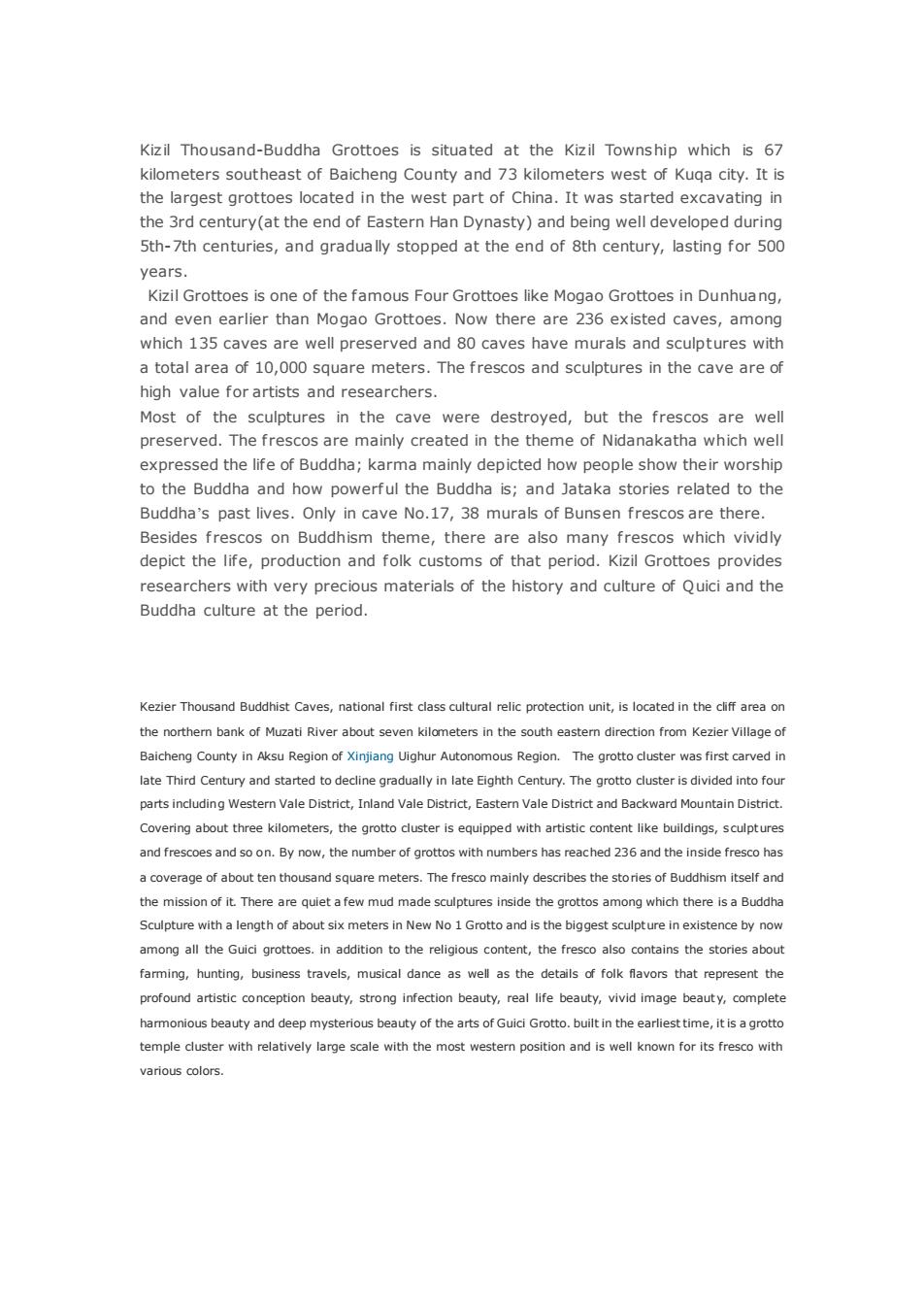正在加载图片...

Kizil Thousand-Buddha Grottoes is situated at the Kizil Township which is 67 kilometers southeast of Baicheng County and 73 kilometers west of Kuqa city.It is the largest grottoes located in the west part of China.It was started excavating in the 3rd century(at the end of Eastern Han Dynasty)and being well developed during 5th-7th centuries.and gradually stopped at the end of 8th century,lasting for 500 tof the famou Four Grottoes ike o and even earlier than Mogao Grottoes.Now there are 236 existed caves,among which 135 caves are well preserved and 80 caves have murals and sculptures with a total area of 10,000 square meters.The frescos and sculptures in the cave are of high value for artists and researchers. Most of the sculptures in the cave were destroyed,but the frescos are wel preserved.The frescos are mainly created in the theme of Nidanakatha which wel expressed the life of Buddha;karma mainly depicted how people show their worship to the Buddha and how powerful the Buddha is;and Jataka stories related to the Buddha's past lives.Only in cave no.17.38 murals of Bunsen frescos are there. Besides frescos eme,there re also many cos which vividly depict the life,production and folk customs of that period.Kizil Grottoes provides researchers with very precious materials of the history and culture of Quici and the Buddha culture at the period. Kezier Thousand Buddhist Caves,national first dass cultural relic protection unit,is located in the northem bank of Muzati River about seven kilometers in the south eastemn direction from Kezier Village of Baicheng County in Aksu Region of Xinjiang Uighur Autonomous Region.The grotto cluster was first carved ir atsihnctdingwC dBackward Covering about three kilometers,thegroto cluster is equipped with artistic content like buildings,scuptures and frescoes and so on.By now,the number of grottos with numbers has reached 236 and the inside fresco has a coverage of about ten thousand square meters.The fresco mainly describes the stores of Buddhism itself and the mission of it.There are quiet a few mud made sculptures inside the grottos among which there is a Buddha gal the Gu.to the,the fresco ntains the stories a farming,hunting,business travels,musical dance as well as the details of folk flavors that represent the profound artistic conception beauty,strong infection beauty,real life beauty,vivid image beauty,complete hammonious beauty and deep mysterious beauty of the arts of Guici Grotto.built in the earliest time,it is a grotto temple cluster with relatively large scale with the most western position and is well known for its fresco withKizil Thousand-Buddha Grottoes is situated at the Kizil Township which is 67 kilometers southeast of Baicheng County and 73 kilometers west of Kuqa city. It is the largest grottoes located in the west part of China. It was started excavating in the 3rd century(at the end of Eastern Han Dynasty) and being well developed during 5th-7th centuries, and gradually stopped at the end of 8th century, lasting for 500 years. Kizil Grottoes is one of the famous Four Grottoes like Mogao Grottoes in Dunhuang, and even earlier than Mogao Grottoes. Now there are 236 existed caves, among which 135 caves are well preserved and 80 caves have murals and sculptures with a total area of 10,000 square meters. The f rescos and sculptures in the cave are of high value for artists and researchers. Most of the sculptures in the cave were destroyed, but the f rescos are well preserved. The f rescos are mainly created in the theme of Nidanakatha which well expressed the life of Buddha; karma mainly depicted how people show their worship to the Buddha and how powerful the Buddha is; and Jataka stories related to the Buddha’s past lives. Only in cave No.17, 38 murals of Bunsen f rescos are there. Besides f rescos on Buddhism theme, there are also many f rescos which vividly depict the life, production and folk customs of that period. Kizil Grottoes provides researchers with very precious materials of the history and culture of Quici and the Buddha culture at the period. Kezier Thousand Buddhist Caves, national first class cultural relic protection unit, is located in the cliff area on the northern bank of Muzati River about seven kilometers in the south eastern direction from Kezier Village of Baicheng County in Aksu Region of Xinjiang Uighur Autonomous Region. The grotto cluster was first carved in late Third Century and started to decline gradually in late Eighth Century. The grotto cluster is divided into four parts including Western Vale District, Inland Vale District, Eastern Vale District and Backward Mountain District. Covering about three kilometers, the grotto cluster is equipped with artistic content like buildings, sculptures and frescoes and so on. By now, the number of grottos with numbers has reached 236 and the inside fresco has a coverage of about ten thousand square meters. The fresco mainly describes the stories of Buddhism itself and the mission of it. There are quiet a few mud made sculptures inside the grottos among which there is a Buddha Sculpture with a length of about six meters in New No 1 Grotto and is the biggest sculpture in existence by now among all the Guici grottoes. in addition to the religious content, the fresco also contains the stories about farming, hunting, business travels, musical dance as well as the details of folk flavors that represent the profound artistic conception beauty, strong infection beauty, real life beauty, vivid image beauty, complete harmonious beauty and deep mysterious beauty of the arts of Guici Grotto. built in the earliest time, it is a grotto temple cluster with relatively large scale with the most western position and is well known for its fresco with various colors